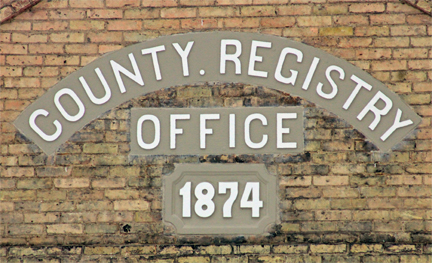Registry Office
In early 1873, Elgin County Council met to discuss the growing need for a Registry Office building. A separate Registry Office was becoming the norm across the province, with buildings being built in the style designated by Provincial Chief Engineer and Architect, Kivas Tully about 1868. The designs included separate  rooms, high vaulted ceilings and iron fittings around the doors and windows, iron bars and shutters, iron doors between rooms and thick walls. This was to lower the risk of fire in the building or fire spreading and to protect the valuable documents held within.
rooms, high vaulted ceilings and iron fittings around the doors and windows, iron bars and shutters, iron doors between rooms and thick walls. This was to lower the risk of fire in the building or fire spreading and to protect the valuable documents held within.
On Wednesday, January 29, 1873, a special committee was appointed to investigate what a “fair portion” would be for the Town of St. Thomas to contribute to a new Registry Office. By the next day, a motion had been made, and amended to appoint a Building Committee to oversee improvements to the Gaol and the building of a Registry Office for the coming year. The Committee included J. Marlatt, Samuel Shepard, and T. M. Narin.
By February 1874, tenders had been received from contractors to build the Registry Office. The contract was awarded to Messrs. Ellison, with the intent that the work would be completed by the first day of October 1874, for the price of $6,770. In addition, a new Building Committee was chosen, including Warden John McCausland (Reeve of Malahide), T. M. Nairn (Reeve of Aylmer) and Samuel Day (Reeve of Yarmouth) to oversee the construction.
On November 10, 1874, Chairman of the Building Committee, John McCausland provided a report to Elgin County Council. The report gave details on alterations that were made to the original design for the purpose of safety, appeal and practicality. The overage in the cost of nearly $1000 was also explained in detail.
The next day, a report from the Special Committee was read and indicated the near completion of the building. The report suggested Registrar John McKay and staff needed to prepare for their move to the Registry Office for December 1st. Once the Registry Office staff was re-situated, the County Treasurer would move into their old offices, and the County Attorney into the former office of the Treasurer.
The Canadian Home Journal provided an overview for their readers about the new Registry Office in their November 13, 1874 issue:
“The New Registry Office
As will be seen in our County Council report the new Registry Office has been completed by the contractor, and the building has been handed over to the County. It is a plain brick edifice, 50 feet in length by 30 in breadth, and one story in height. The foundation is of Ohio freestone, resting upon St. Mary’s limestone, the walls and partitions of solid brickwork, two feet in thickness. The roof is of brown slate. A small porch, or ante-room leads in to the public room, 14 feet by 12, where parties calling on business will find the Registrar during office hours. Off this room, to the right, is a private room, 12 feet by 10, for the convenience of parties who may wish to make lengthy searches. Both rooms are furnished with counters. The Clerks’ copying room comes next. It is 24 feet by 14, and is lighted by windows on both sides of the building. Beyond is the vault, a room of the same size, designed for the safe keeping of registry books and registered instruments. It is furnished with strong sheet-iron shelving arranged into 418 ‘pigeon holes.’ The floor of the building is laid with handsome flag stones, four inches in thickness, which rest on parallel walls of solid stone work, filled in with concrete. Each room has an arched roof of brickwork, solid to the outer roof of the building. The window frames, sash an shutters, and the double door leading to each room are of iron, - the aim being to make the building as nearly fire proof a possible. A tramway will be laid down from the vault to the front office for facility in moving the heavy books backward and forward, and to save them from inordinate wear and tear. Altogether, the building appears to be admirably adapted for its purpose, and we think justifies the boast of the Warden that it is one of the best, if no the best of its kind in the Province. The council in adopting the building committee’s report expressed themselves as well pleased with the manner in which the Messrs. Ellison had completed their contract. It is thought that the office will be ready for occupation by the first of December.”
Although the article and the committee report to Council suggested the Registrar would be able to move in by December 1, the building was not sufficiently dried to make its occupancy safe. A medical examination of the premises was made the first part of December and the report was unfavorable. John McKay and his staff made the move to the new building in early January 1875.
